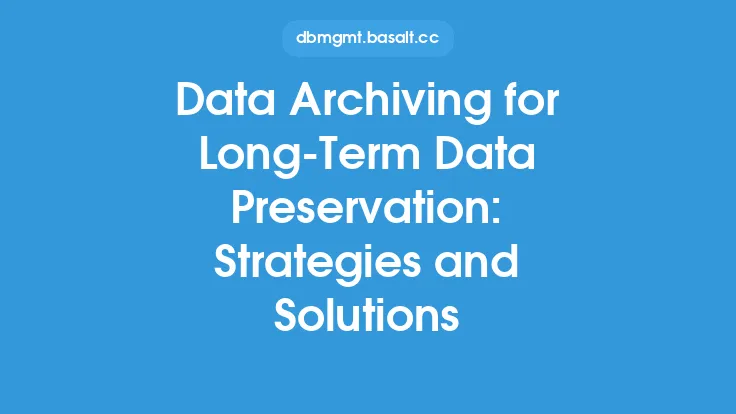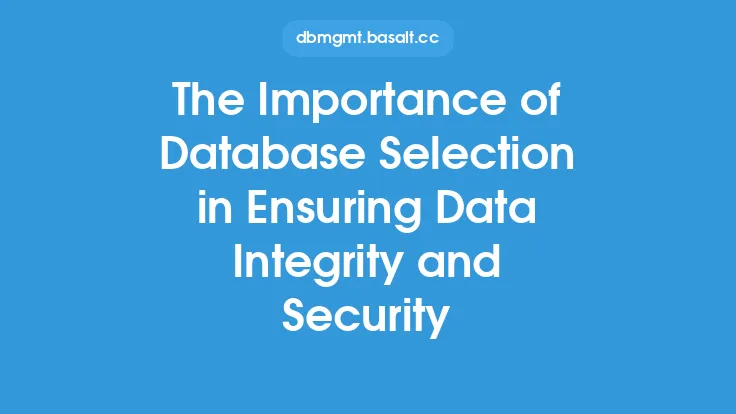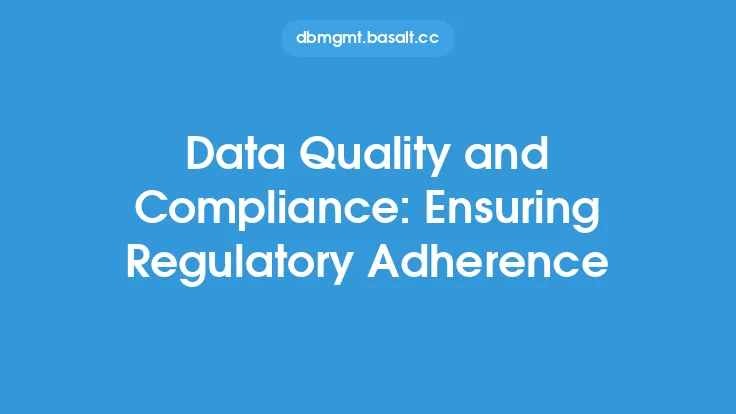Data validation is a critical process in ensuring the accuracy, completeness, and consistency of data in various systems, applications, and databases. It involves checking and verifying the data against a set of predefined rules, constraints, and formats to ensure that it meets the required standards and specifications. In the context of data normalization, data validation plays a vital role in ensuring data compliance and security by preventing incorrect, incomplete, or malicious data from entering the system.
Introduction to Data Validation Strategies
Data validation strategies are designed to ensure that data is accurate, reliable, and secure. These strategies involve a combination of techniques, tools, and methodologies that help to identify and prevent data errors, inconsistencies, and vulnerabilities. Some common data validation strategies include data type checking, range checking, format checking, and cross-validation. Data type checking involves verifying that the data is of the correct type, such as integer, string, or date. Range checking involves verifying that the data falls within a specified range or limit. Format checking involves verifying that the data conforms to a specific format or pattern. Cross-validation involves verifying the data against other data or sources to ensure consistency and accuracy.
Types of Data Validation
There are several types of data validation, including manual validation, automated validation, and hybrid validation. Manual validation involves manually checking and verifying the data against a set of predefined rules and constraints. Automated validation involves using software tools and algorithms to check and verify the data. Hybrid validation involves a combination of manual and automated validation techniques. Each type of validation has its own advantages and disadvantages, and the choice of validation type depends on the specific requirements and needs of the system or application.
Data Validation Techniques
Data validation techniques are used to check and verify the data against a set of predefined rules and constraints. Some common data validation techniques include regular expressions, checksums, and digital signatures. Regular expressions involve using pattern-matching algorithms to verify that the data conforms to a specific format or pattern. Checksums involve using mathematical algorithms to verify the integrity and accuracy of the data. Digital signatures involve using cryptographic algorithms to verify the authenticity and integrity of the data. These techniques can be used alone or in combination to provide a robust and effective data validation process.
Data Validation Tools and Software
There are several data validation tools and software available, including open-source and commercial products. Some popular data validation tools include data validation frameworks, data quality tools, and data governance platforms. Data validation frameworks provide a set of pre-built rules and constraints that can be used to validate data. Data quality tools provide a range of features and functions for data validation, data cleansing, and data transformation. Data governance platforms provide a comprehensive framework for data management, including data validation, data security, and data compliance. The choice of data validation tool or software depends on the specific requirements and needs of the system or application.
Best Practices for Data Validation
Best practices for data validation involve a combination of techniques, tools, and methodologies that help to ensure the accuracy, completeness, and consistency of data. Some best practices for data validation include defining clear and concise validation rules, using automated validation techniques, and testing and verifying the validation process. Defining clear and concise validation rules involves specifying the exact rules and constraints that the data must meet. Using automated validation techniques involves using software tools and algorithms to check and verify the data. Testing and verifying the validation process involves testing the validation rules and constraints to ensure that they are working correctly and effectively.
Data Validation and Compliance
Data validation plays a critical role in ensuring data compliance with regulatory requirements and industry standards. Compliance involves adhering to a set of rules, regulations, and standards that govern the collection, storage, and use of data. Data validation helps to ensure that data is accurate, complete, and consistent, which is essential for compliance. Some common regulatory requirements and industry standards that require data validation include GDPR, HIPAA, and PCI-DSS. GDPR requires organizations to ensure the accuracy, completeness, and consistency of personal data. HIPAA requires organizations to ensure the confidentiality, integrity, and availability of protected health information. PCI-DSS requires organizations to ensure the security and integrity of payment card data.
Data Validation and Security
Data validation plays a critical role in ensuring data security by preventing incorrect, incomplete, or malicious data from entering the system. Data security involves protecting data from unauthorized access, use, or disclosure. Data validation helps to prevent data breaches, cyber attacks, and other security threats by ensuring that data is accurate, complete, and consistent. Some common data security threats that can be prevented through data validation include SQL injection, cross-site scripting, and buffer overflow attacks. SQL injection involves injecting malicious code into a database to extract or modify sensitive data. Cross-site scripting involves injecting malicious code into a web application to steal or modify sensitive data. Buffer overflow attacks involve overflowing a buffer with malicious code to execute unauthorized actions.
Conclusion
In conclusion, data validation is a critical process in ensuring the accuracy, completeness, and consistency of data in various systems, applications, and databases. Data validation strategies, techniques, and tools are used to check and verify the data against a set of predefined rules and constraints. Best practices for data validation involve defining clear and concise validation rules, using automated validation techniques, and testing and verifying the validation process. Data validation plays a critical role in ensuring data compliance and security by preventing incorrect, incomplete, or malicious data from entering the system. By implementing effective data validation strategies and techniques, organizations can ensure the accuracy, completeness, and consistency of their data, which is essential for making informed business decisions, ensuring regulatory compliance, and preventing data security threats.





